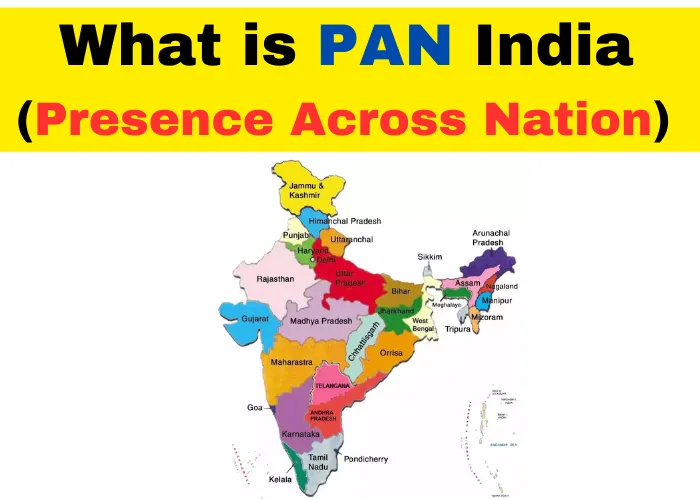Contents
- 1 Characteristics of PAN-India Companies
- 2 Examples of PAN-India Companies
- 3 Advantages and Challenges of Being a PAN-India Company
- 4 Challenges
- 5 Conclusion
- 6 FAQs:
- 6.1 What is the meaning of PAN India?
- 6.2 What are the benefits of being a PAN-India company?
- 6.3 Are there any challenges associated with operating as a PAN-India company?
- 6.4 What types of companies can be classified as PAN-India companies?
- 6.5 How can companies expand their operations to become a PAN-India company?
- 6.6 Is it necessary for companies to become PAN-India to be successful in India?
- 6.7 What are some examples of PAN-India companies in India?
Learn about PAN India (Presence Across Nation), a term that refers to companies with a presence across the entire nation, and its advantages and challenges. Discover how companies can become PAN-India and examples of such companies in India.
In India, the term PAN is often used as an acronym for Permanent Account Number, which is a unique identification number assigned to taxpayers. However, in the context of business and commerce, another interpretation of PAN is gaining popularity. This interpretation stands for Presence Across Nation, and it refers to a company or organization that has established operations, services, or products across different regions, states, or territories of India.
In this article, we will explore the characteristics of PAN-India companies, provide examples of such companies in different sectors, and examine the advantages and challenges of establishing a PAN-India presence.

Characteristics of PAN-India Companies
PAN-India companies share several common traits that distinguish them from companies with a more limited or regional presence. These traits include:
1. Extensive geographical reach
PAN-India companies have a presence in multiple states, regions, or territories across the country. They often have a network of offices, branches, or franchises that allows them to serve customers from different parts of the country. This extensive geographical reach enables them to cater to a wider customer base and to have a greater market share.
2. Wide customer base
PAN-India companies serve customers from different socio-economic backgrounds, cultures, and regions of India. This diverse customer base allows them to offer a variety of products and services that cater to different needs and preferences. They may also adopt region-specific marketing strategies that appeal to customers from different parts of the country.
3. Multicity operations
PAN-India companies have operations in several cities and towns across the country. This may involve setting up manufacturing plants, distribution centers, or retail outlets in different parts of the country. This multicity presence enables them to tap into local markets and to offer localized products and services.
4. Large market coverage
PAN-India companies have a significant market coverage across different regions and sectors of the Indian economy. This large market coverage may give them an advantage in terms of market share, revenue, and brand recognition.
Examples of PAN-India Companies
PAN-India companies have established a strong foothold in various sectors of the Indian economy. Here are some examples of such companies:
1. Banking and Finance
The banking and finance sector in India has seen the emergence of several PAN-India players. These include State Bank of India, HDFC Bank, ICICI Bank, Axis Bank, and others. These banks have a widespread presence across the country and offer a range of banking and financial services to their customers.
2. Telecommunications
The telecommunications sector in India has witnessed a massive transformation in the past few decades. Companies like Reliance Jio, Bharti Airtel, Vodafone Idea, and BSNL have a PAN-India presence and offer their services to millions of customers across the country.
3. E-commerce
E-commerce has become a dominant force in the Indian retail industry, and several companies have established a PAN-India presence in this sector. These include Amazon, Flipkart, Snapdeal, and Myntra, among others. These companies offer a wide range of products and services to customers across the country and have leveraged technology to expand their reach and market coverage.
4. Retail
Retail is another sector that has seen the emergence of several PAN-India players. These include companies like Reliance Retail, Future Group, and Aditya Birla Retail, among others. These companies have established a widespread network of retail outlets across different cities and towns in India, catering to the diverse needs and preferences of Indian consumers.
Advantages and Challenges of Being a PAN-India Company
Establishing a PAN-India presence offers numerous advantages to companies, but it also comes with its own set of challenges.
Advantages
Access to a wider customer base: PAN-India companies have a larger potential customer base than those that are limited to one particular region or city. With a widespread presence, these companies can access a much larger audience, which can lead to increased sales and profits.
Greater market share and revenue: With a larger customer base comes the potential for a larger market share and revenue. By expanding their operations to different parts of the country, companies can tap into previously untapped markets and gain an edge over their competitors.
Enhanced brand recognition: A widespread presence in different parts of the country can help companies build a stronger brand image. With more people exposed to their products or services, they can build a reputation for quality and reliability that can help them stand out from the competition.
Challenges
Increased competition: With a larger potential customer base comes increased competition. Companies that expand their operations to different parts of the country will have to compete with other players in the market that are already established in those regions. This can make it difficult for new players to gain a foothold in the market.
Regulatory compliance across different states: Companies that operate in multiple states will have to comply with different regulatory frameworks. This can make it more difficult to ensure compliance with all the relevant laws and regulations, which can lead to legal problems and other complications.
Logistical and operational complexities: Operating in multiple states can also create logistical and operational challenges. Companies will have to deal with issues such as transportation, supply chain management, and coordination between different branches or offices.
Conclusion
PAN-India companies have become an increasingly important part of the Indian business landscape. They offer numerous advantages, such as access to a wider customer base, greater market share and revenue, and enhanced brand recognition. However, there are also challenges associated with establishing a PAN-India presence, such as increased competition, regulatory compliance across different states, and logistical and operational complexities.
Despite these challenges, many companies have successfully established a PAN-India presence, and the trend is likely to continue in the future. As the Indian economy continues to grow and evolve, we can expect to see more companies expanding their operations to different parts of the country, offering their products and services to a wider audience than ever before.
FAQs:
What is the meaning of PAN India?
PAN India refers to companies or organizations that have a presence across the entire nation, with operations in multiple states and regions.
What are the benefits of being a PAN-India company?
Being a PAN-India company offers many advantages, such as access to a wider customer base, increased market share and revenue, and enhanced brand recognition.
Are there any challenges associated with operating as a PAN-India company?
Yes, there are several challenges, such as increased competition, regulatory compliance across different states, and logistical and operational complexities.
What types of companies can be classified as PAN-India companies?
Companies that have a presence across the entire country and operate in multiple states can be classified as PAN-India companies. This includes large corporations, small and medium enterprises (SMEs), and even startups.
How can companies expand their operations to become a PAN-India company?
Companies can expand their operations by establishing new offices or branches in different parts of the country, setting up distribution networks, and partnering with local businesses or organizations.
Is it necessary for companies to become PAN-India to be successful in India?
No, it is not necessary for companies to be PAN-India to be successful in India. However, expanding operations to multiple states and regions can offer significant benefits and help companies gain a competitive edge in the market.
What are some examples of PAN-India companies in India?
There are many companies that can be classified as PAN-India, including Tata Group, Reliance Industries, HDFC Bank, and Hindustan Unilever Limited, among others.

![Corporate Accounting [Important Questions & Answers with MCQ] Corporate Accounting Important Questions & Answers](https://edukar.in/wp-content/uploads/2022/09/Corporate-Accounting-Important-Questions-Answers-1024x597.webp)



![Zoology Important Questions [Class 11th-English medium] Zoology Important Questions class 10 english medium](https://edukar.in/wp-content/uploads/2022/09/Zoology-Important-Questions-class-10-english-medium-1024x597.webp)
![Web application and Security Class 10 [Questions Answers & MCQs] Web application Class 10 Questions & Answers](https://edukar.in/wp-content/uploads/2022/09/Web-application-Class-10-Questions-Answers-1024x597.webp)
![Biology Class 10 Very important [Questions &Answers] Biology Important Questions with Answers class 10](https://edukar.in/wp-content/uploads/2022/09/Biology-Important-Questions-with-Answers-class-10-1024x597.webp)




![Digital Documentation Class 9 [Questions Answers & MCQ] Digital Documentation Class 9](https://edukar.in/wp-content/uploads/2022/08/Digital-Documentation-Class-9-1024x597.webp)



